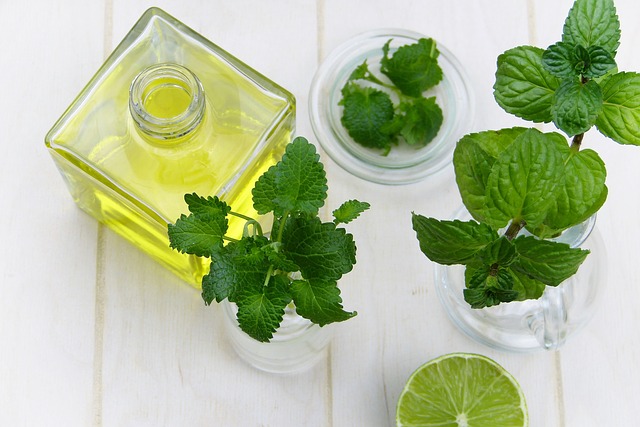Recognitions by a special refreshing aroma and exceptional healing properties, mint is a very popular plant that is used in cosmetology, perfumery, distillery, confectionery, traditional and folk medicine, as well as in cooking. Mint is a genus of plants of the family. Mint is a highly aromatic plant, due to the presence in its composition of a large amount of menthol. It has more than 20 species and a hundred subspecies, the most famous representatives are peppermint, garden mint, water mint, and Japanese. The period of flowering mint from the end of June to September, and for the growth of mint prefers the moderate latitudes of the Northern Hemisphere.
Composition and Calorie Content of Mint
Mint contains essential oil up to 2.75% in leaves up to 6% in inflorescences, resinous and tannic substances, hesperidin, carotene; acids – ascorbic, chromogenic to 0.7%, coffee up to 2%, frolic to 0.3% and oleic to 0.12%, as well as rutin, betaine, arginine, neutral saponins, rhamnose, glucose and phytosterol. And in seeds, up to 20% of fatty oil is found. Essential oil of mint is colorless, with a greenish or yellowish tint and a pleasant refreshing aroma. The main component of essential peppermint oil is menthol, which is responsible for saturated persistent refreshing odors. The caloric content of mint is about 47 kcal / 100 g of fresh leaves.
Use as Food Products
Mint takes a worthy place in cooking. It is used in the preparation of ice cream, chocolate, sweets, candies, various desserts, alcoholic and non-alcoholic beverages. Thanks to the fresh menthol flavor, mint leaves are used for marinades, dressings, and sauces, thus improving the flavor and aromatic qualities of the dishes. In addition, mint leaves are often used to decorate dishes. In summer, it’s best to quench your thirst and refresh yourself with drinks with mint.
Use as Medicine
In addition to the widespread use in cooking, peppermint, and in particular its essential oil, is used in cosmetics, perfumes, air fresheners, as well as in the manufacture of medical preparations (e.g., inhalers for the throat). In addition, the market is full of products that include mint extract – toothpaste, shampoos and soaps, bath foams, aromatic sticks, chewing gums, breath fresheners, etc. Mint has a lot of useful properties. Let’s talk only about some of them.
Useful properties of mint
-
- Thanks to the typical fresh flavor, mint is a good snack conducive to digestion. It will help with stomach upset, inflammation and other gastrointestinal problems. The aroma of mint activates the salivary glands in the mouth, as well as the glands that secrete digestive enzymes, thereby promoting digestion.
- The strong refreshing aroma of mint is an excellent and quick remedy for nausea. Whenever you feel nauseous, inhale the aroma of mint essential oil, chopped fresh mint leaves or suck a candy with mint flavor and nausea will pass.
- Mint is an excellent folk remedy for a headache and nasal congestion, it is enough to apply a few drops of mint essential oil on fingers and rub them with a forehead or nose.
- A strong mint flavor is a very effective remedy for respiratory diseases such as asthma, influenza, bronchitis, pneumonia, tonsillitis, colds, cooling and soothing the throat, nose and respiratory tract and easing the condition when coughing. It is these properties that balms are based on mint. Unlike other inhalers, which are based on aerosols, mint-based inhalers are more effective and natural.
- Regular use of peppermint, both fresh and on the basis of tea, is very useful for asthma patients, as it helps to improve the health status. However, an overdose can cause irritation of the respiratory tract.
- Since mint essential oil is a good antiseptic, it is recommended to use it for skin cleansing. It soothes the skin, heals infections, itching, as well as acne and acne. And anti-inflammatory properties make it possible to use it to treat insect bites: mosquitoes, bees, hornets, wasps.
- Possessing bactericidal properties, mint is a known natural freshener for breathing and oral cavity, disinfecting and suppressing the growth of harmful bacteria.
- Current research shows that certain enzymes present in mint can help in the treatment of cancer.
- In addition to all the listed properties, mint is also a good laxative, helping to get rid of constipation and gas formation in the intestine.
- Another specific property of mint is that, despite its cooling and soothing effect, it can cause sweating if you drink a drink or tea based on mint in the hot season.
- Mint juice is recommended for use with burns on the skin. It is also useful for rheumatism.
- An excellent way to relax and calm the nerves is a cup of mint tea. It will help cope with nervous disorders, stress, depression, and insomnia.
- However, mint has contraindications to use, for example, individual intolerance and pregnancy. Excessive use of mint, tea with mint or inhaling mint oil can provoke restless sleep and migraines.
Mint for weight loss
Since mint helps to cope with constipation and cleanse the intestines, normalize the work of the gastrointestinal tract, it indirectly contributes to the process of losing weight. There is an opinion that if you inhale the specific menthol aroma of essential oil of mint during the day, the saturation signal will come to the brain sooner than usual and as a consequence, you will eat 25% less food. Tea with mint not only quenches thirst and helps to freshen up, but also gives a feeling of satiety.
Author Bio
Eva Vosper is a well-educated and experienced wellbeing mentor. She is the most talented lecturer in the medical institutes across the European countries. In this article, she illuminates the benefits of mint on the health. Moreover, she also works with Dissertation Help UK for the assistance of pupils in their academic career to support them all in accomplishing their desired educational objectives.
















